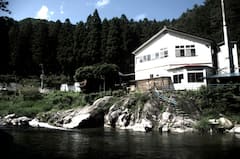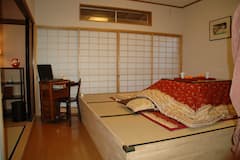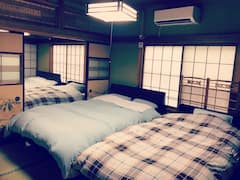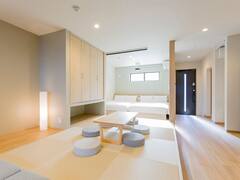Nikko is a city located in the Tochigi Prefecture, in the northern Kantō region of Japan. The city has an estimated population of 84,197. Nikko is home to the mausoleums of the Tokugawa Shoguns, which are listed on the UNESCO World Heritage List. The landscapes in Nikko are heavily influenced by the Chinese, with multicoloured carvings and heavy gaudy and ornate designs on its buildings.
However, besides the many spiritual and historical landscapes and attractions in Nikko, such as the three main temples: Toshogu, Rinnoji, and Futarasan, the Shinkyō Bridge, the Takino-o Shrine, the Kanmangafuchi Abyss, the Tamozawa Imperial Villa Memorial Park and the very popular Nikko Botanical Garden, Nikko is also home to a whole bunch of local food, and most of which are exceptionally delicious. Come with me on this journey of culinary discovery!
Yuba

If you happen to be a non-tofu lover, you might just change your mind after trying this Nikko specialty. Yuba, also known as tofu skin or bean curd skin, is a food product made from soy beans. The process of making this is that during the boiling of the soy milk, a film or skin normally forms on the liquid surface. This skin is collected and dried into yellowish sheets called Yuba. It is not necessarily referred to as tofu but it does have a similar texture and flavour to some tofu products. The Yuba has been a delicacy since the 16th century and it is widely savoured, fresh, fermented, or dried, in Chinese and Japanese cuisine and is commonly used to wrap dim sum.
There are many different ways to eat the Yuba and in the Tsuruya Yuba Restaurant in Nikko, its menu has different Yuba dishes, from the savoury Yuba soba to the sweet Yuba custard pudding. This restaurant has received many positive feedback for its traditional interior and its friendly staff. There is also a souvenir shop located next to the restaurant selling Yuba-related products. The restaurant is also located near Kegon Falls and is situated on the main street, alongside Lake Chuzenji.
つるや湯葉店 今市店 Tsuruya Yuba Restaurant
Address: 10-6 Kawamuro, Nikko, Tochigi Prefecture
Opening Hours: 11am - 3:30pm.
Access: Walking distance from Ōkuwa Station
Contact: +81 288-21-7641
Soba

Soba is a noodle dish made from buckwheat flour and is usually served either chilled with a dipping sauce, or in hot broth as a noodle soup. Soba can also be served as either an inexpensive food option sold at railway stations or at expensive specialty restaurants. At markets, instant versions of the Soba, such as those with instant noodle broth, are sold, making it easy to prepare at home. Soba has many nutritional benefits. For example, thiamine (vitamin B1) is present in Soba and prevents diseases such as beriberi. Also, thiamine is not present in white rice, making soba a good nutritional addition to a diet reliant on white rice. Soba also contains lysine, which is lacking in wheat flour, and all eight essential amino acids.
The Santate Soba Nagahataan restaurant is known for being one of the most famous Soba restaurants in Nikko. With constant 4/5 star ratings on travel websites, this place is highly recommended amongst locals and tourists alike. This restaurant exudes a traditional Japanese vibe from both the exteriors and its interiors and its soba dishes are served in generous portions.
三たてそば 長畑庵 Santate Soba Nagahataan
Address: 635-1 Nagahata, Nikko-city
Opening Hours: 11am - 4pm.
Contact: +81 288-27-2488
Udon

Unlike Soba, Udon is made from thick wheat flour and is generally thicker as compared to Soba. Udon is commonly served hot as a noodle soup in a mildly flavoured broth that is usually made of dashi, soy sauce, and mirin and topped with thinly chopped scallions. Other additional toppings include tempura, prawn, kakiage (a type of mixed tempura fritter) and more. Just like any other noodle dish in Japan, the Udon can be eaten chilled or hot and its dishes and toppings are similar to that of Soba. The thickness and shape of Udon vary with the regions. For example, in Kiryū, Gunma, Udon is normally flat and wide in shape. While in Fukuoka, Udon are thick and soft.
While you’re in Nikko, head over to Sanbonmatsu chaya for one of the best Udon in Nikko. This wheelchair-accessible restaurant serves set lunch and dinner menus in its rather huge traditionally-designed building. Must-try items on their menu include the Udon and Soba dishes, the tomato curry and the Grilled ginger pork dish.
三本松茶屋 Sanbonmatsu chaya
Address: 2493 Chūgūshi, Nikkō-city
Opening Hours: 7am - 7pm
Access: 60 minutes’ bus ride from Tobu-Nikko Station (Yumoto Onsen bound) then a 1-minute walk from Sanbonmatsu bus stop
Contact: +81 288-55-0287
Yōkan (Sweet Bean Jelly)

Yōkan is a thick, jelly dessert made of red bean paste, agar, and sugar. There are two main types of Yokan, the first being the neri yōkan, and the second, mizu yōkan. “Mizu” means “water”, and indicates that it is made with more water than usual. The Mizu Yokan is commonly chilled and eaten in the summer periods in Japan. The yokan is normally served in block form and eaten in slices. Besides red bean paste, Yokan that are made from white kidney beans are also commonly found in Japan. They may also contain chopped chestnuts, persimmons, whole sweetened azuki beans, figs, and sweet potato. Creative additions such as powdered green tea are also widely savoured.
In Nikko, visit Mitsuyama Yokan, which sells the well-known Yokan in Nikko and has long queues forming outside its store every day. This store is known for its bite-sized Yokan, handwrapped one by one in bamboo, which makes these tiny desserts convenient as both take-home souvenirs and snacks on the go. This store is located between Tobu Nikko Station and the World Heritage area and is three storeys high, easy to spot along the street. Must-try items would be their Matcha jelly Yokan and the Chestnut Jelly Yokan.
三ツ山羊羹 Mitsuyama Yokan
Address: 914 Nakahatsuishi-cho, Nikko-city
Contact: +81 288-54-0068
You might be interested in these Airbnbs!
Shaved ice made from the natural spring water of Nikko

Shaved ice, or Kakigori, is normally served with flavoured syrups and toppings and is a popular dessert that is normally savoured during summer in Japan. The Kakigori is commonly found in cafés or shops and in Japan, there are currently only 5 icehouses selling the Kakigori. In Nikko, the Kakigori is made from Nikko’s natural water from the mountains and 3 out of the 5 icehouses in Japan are in Nikko. The shaved ice is normally served with a wide range of flavours. Each shop happens to have their own speciality of the shaved ice such as the Matcha ( powdered green tea) shaved ice that is served with syrup and bean jam toppings or the standard ones that are served with strawberry or melon syrup.
One of the 3 icehouses in Nikko is the Coffee Shop Spoon, which is known for their bestseller, the strawberry shaved ice served with sweet condensed milk. It is also topped with cotton candy, making it visually appealing. This shop has received positive reviews on travel websites for its amazing Kakigori, quick service and great staff.
Coffee Shop Spoon
Address: 2478 Chugushi, Nikko-city
Contact: +81 288-55-0022
Manju

Manju is a very popular Japanese confectionery and comes with a ton of varieties but its exterior is commonly made from flour, rice powder and buckwheat and its filling made from boiled azuki beans and sugar. These items are boiled together and kneaded. Its paste can also come in a lot of varieties including koshian, tsubuan, and tsubushian. Manju is actually derived from a type of mochi, pounded rice cake, and is originally called mantou in Chinese. Today, the Manju can be commonly found in the different bakeries and shops across Japan. Similar to the Yokan, Manju also comes in the Mizu-Manju form which is commonly eaten as a summer dessert in Japan. There is also the Yuba Manju, which is Manju wrapped in Yuba and the Onsen Manju, which is a typical souvenir given at hot spring resorts.
In Yudaki Falls, there is a famous Manju shop that is situated at the rest area nearby and its bestseller would be the Karinto Manju. Karintou is a deep fried flour and sugar outer dough and the Karintou Manju has a sweet bean paste filling and is served warm.
“Tochi-Otome”, Tochigi’s famous strawberry

The Tochigi Prefecture is home to one of Japan’s best producer of strawberries. Many from all over Japan and the rest of the world come here to taste the strawberries. Made from intensive research and advanced cultivation techniques, the strawberries here are distinguished for their bright red colour, large size, and also for providing the perfect balance between sweetness and sourness. The strawberries here are guaranteed to be fresh and sweet, and are commonly enjoyed during the winter and spring.
In Nikko, head down to the Nikko Strawberry Park, one of the most famous strawberry park in Japan, to try your hand at strawberry picking. This strawberry farm has refrained from the use of chemical fertilisers and instead uses organic fertilisers and its strawberries are produced using natural sunlight, resulting in its crisp skin and sweetness. The strawberry picking will be available when the strawberries are in season, which is normally during the months of April, May and December. Reservations are required!
Nikko Strawberry Park
Address: 3581 Serinuma, Nikko-city
Contact: +81 288-22-0615
Opening season: Usually December to early June. Please contact them beforehand.
Nikko Maitake Mushroom

The Maitake mushroom, or more commonly referred to in Japan as the dancing mushroom, got its name from the way it was discovered. It was believed that a group of Buddhist nuns discovered these mushrooms and got really attached to its delicious taste, and danced in joy. The Maitake is a soft polypore mushroom and normally grow out of forest grounds during the summer to early autumn. They can be very big, with some even reaching 50lbs (22 kg)!
In Nikko, the mushrooms are cultivated at the bottom of the mountains and they are cultivated without the use of pesticides. They are known as one of the best cultivated Maitake mushrooms in Japan for their great taste and flavour. Maitakke mushrooms are normally served with a flavoured broth together with noodles or rice and other food items. Multiple restaurants and even cafés have Maitake mushroom dishes on their menus.
Shojinryouri

The Shojinryouri is a vegetable diet that is normally prepared for Buddhist priests and monks who are forbidden to eat any kind of meat. This diet is also an essential practice that promotes one’s devotion for the Buddhist discipline. The preparation of the Shojinryouri is based on simplicity and harmony, so its dishes also follow closely with these practices. Each meal must have a balance between 5 different colours and flavours and nutritional balance is also taken into consideration.
Ingredients such as garlic and onion, which are present in other vegetarian recipes, are not included in the Shojinryouri. Common ingredients present in the Shojinryouri, however, are mainly abura-age (fried soybean curd). Goma-dofu (sesame tofu), koya-dofu (dried tofu), yuba (soy milk film), fu (wheat gluten), konnyaku (rum root cakes) and natto (fermented soy beans). In Nikko, you can try the Shojinryouri at the Nikko Park Lodge. The lodge also offers other vegetarian a la carte dishes and breakfast menu items as well.
堯心亭 Gyoshintei
Address: 2339-1,Yamauchi, Nikko-city
Access: 15-minute walk from Tobu-Nikko train station
Opening Hours: 11am - 7pm
Contact: +81 288-53-1201
Ramen

Ramen is made from Chinese-style wheat noodles, and is commonly served with meat or fish-based broth, and includes a variety of toppings such as sliced pork, dried seaweed and green onions. Throughout Japan, there are many variations of this noodle dish, from the difference in the broth, whether it’s served hot or cold, dry or accompanied with broth. Ramen is actually the Japanese pronunciation of the Chinese lamian, although its origin is unclear. It has become a Japanese cultural icon over the years, with local varieties and even a museum that was opened in Yokohoma in 1994.
In Nikko, there are ramen stalls available in every corner. You can even find the instant ones at the local supermarkets. The more known restaurants, such as the Hippari Dako, are constantly swarmed with patrons waiting to try their ramen dishes. This restaurant has been around for almost 25 years and its other must-try menu items include curry udon, yuba sashimi and yaki-udon (fried noodles).
ひっぱり凧 Hippari Dako
Address: 1011 Kamihatsuishimachi, Nikko-city
Opening Hours: 11am - 8pm
Contact: +81 288-53-2933
Wagyu beef

The Wagyu beef is Japan’s top-graded beef and is made from intense marbling, increasing its fat percentage, resulting in it being juicy and tender. Wagyu beef is normally served grilled and with an accompanied broth. The ones in Nikko are called Tochigi Beef and are made from local cows and are known for their unique taste that is so delicious, they could be compared to Kobe Beef! The best restaurant in Nikko to get Wagyu beef? Guruman’s Wagyu! Although it’s a little pricey, its high-quality beef would have you come back for more. They also have fixed-priced menus and has constant 4/5 star ratings on travel websites. Its location is rather difficult to access but a short taxi ride from Nikko station will get you there in no time! This restaurant is very popular amongst the locals so reservation is highly recommended!
Guruman's Wagyu
Address: 1541-297 Tokorono, Nikko-city
Opening Hours: 9am - 6pm. Closed on public holidays.
Access: Short taxi ride from Nikko Station
Contact: +81 288-53-3232
Yakitori

Hippari Dako also serves another Nikko specialty, the Yakitori. Yakitori is a type of Japanese skewered meat, normally beef, chicken or pork. The preparation of Yakitori involves pieces of meat that are roughly of uniform shapes and then skewered with kushi, followed by the seasoning and the grilling. They are normally grilled over charcoal fire with high heat and served. Yakitori can be eaten on its own or with rice or an accompanying dish. Another type of Yakitori, the Kushiyaki, involves the mixture of poultry and non-poultry items, skewered and grilled, such as the enoki maki which consists of enoki mushrooms wrapped in slices of pork.
ひっぱり凧 Hippari Dako
Address: 1011 Kamihatsuishimachi, Nikko-city
Opening Hours: 11am - 8pm.
Contact: +81 288-53-2933
Belly good!
With that much local specialties in just one city of Japan, your belly’s in for a treat! Be sure not to miss out on Nikko’s various spiritual and historical attractions while you’re there as well!
History
Get Trip101 in your inbox
Unsubscribe in one click. See our Privacy Policy for more information on how we use your data






















Create an account to